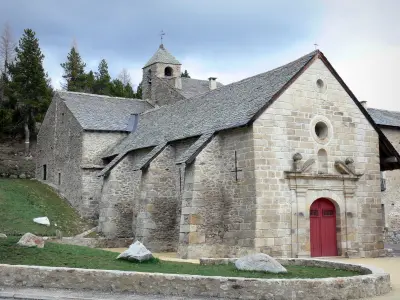Enveitg is a commune in the Pyrénées-Orientales department, in the Occitanie region, 29 km south-east of Pas-de-la-Case (Andorra), by road.
Bordering Spain to the south, its territory of 30 km² oscillates from 1179 to 2579 m in altitude and belongs to the historical and cultural region of Cerdanya.
The village developed to the south, below the current national road 20, at the edge of the Carol valley and at the foot of the Carlit massif to the north.
Doubly served by rail (Enveitg is connected to Perpignan and Toulouse by the regional train and is the terminus station of the Yellow Train which serves Cerdagne from Vernet-les-Bains), the locality has typical landscapes of average and high mountains. It is covered with natural herbaceous environments (55% of its area), areas devoid of vegetation (20%), but also meadows and forests.
Close to renowned resorts and major tourist sites (Andorra, Font Romeu), the town, which has some 690 inhabitants, highlights its heritage and its potential in terms of hiking…
The parish church of Saint-Saturnin is the jewel of the municipal heritage, in the heart of the small town. It was built at the end of the 12th century and then remodeled in the 17th and 18th centuries. It is the part of its semi-circular apse preserved in its original state, in the Romanesque style, in freestone, which is of the greatest interest. There is an apse window with triple splaying, the decoration of which is particularly neat (arching, capitals, frieze). This bay justified the inclusion of the church in the Inventory. The bell tower building with a sloping roof (to protect against too thick layers of snow) also houses a 16th century pulpit and several altarpieces (notably at the high altar, from the 18th century).
In the village, we will also notice the wrought iron cross which adjoins the church, vestiges of the work of the blacksmith (rock posts where horses were tied), old traditional dwellings in granite or again the town hall, recent, but also built in a Pyrenean and mountain style.
Still in terms of heritage, then head to the hamlet of Brangoli to the north: there is located the dolmen of "la cova del Camp de la Marunya", where we notice cupules (small basins) dug by our ancestors in the Neolithic period (between 5800 and 2500 years before our era).
In this same hamlet, the Saint-Fructueux chapel houses several beautifully crafted objects or works, such as the altarpiece of the high altar (18th century), a 17th century painting or even a processional cross...
On the leisure plan, in the village itself, a bowl (bowl track) and a pump-track (all-terrain and acrobatic circuit for two-wheelers) are accessible free of charge for young and old.
It is then advisable to take advantage of the many hiking trails (for walkers or riders) accessible in the town, by climbing to the summit of Carlit or by following the paths along the high plain of Cerdanya. So many routes dotted with remarkable viewpoints over the Pyrenean massif, protected natural areas and the streams that descend from the heights. Pay attention to the difficulties linked to the relief as well as the weather conditions, even in summer. Maps and information at the town hall on +33 4 68 04 81 34 or at the tourist office on +33 4 68 04 15 47. of the 20th century and which connects the high localities of Cerdanya. Including passages over imposing works of art, a trip on the yellow train is one of the essentials during a stay in the Pyrenees... The opportunity to discover the imposing station of Latour-de-Carol - Enveitg (its influence covers the two towns but its access is located on Enveitg): it has the long covered platform plug in Europe and above all has the specificity of being able to accommodate trains running on standard, metric or Iberian gauge tracks. Information on +33 4 68 04 15 47.





























